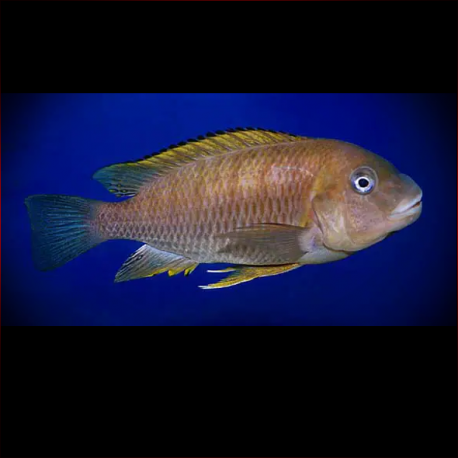More info
Datasheet
| Minimum Tank Size | 110 litres / 29.06 US gallons |
| Maximum Size | 15.0cm / 5.91inches |
| Temperature | 24°C / 75.20°F - 27°C / 80.60°F |
| Hardness | 8-25ºdH |
| pH | 7.5-9.0 |
General Description
Petrochromis famula, a member of the Cichlidae family, is a cichlid species endemic to Lake Tanganyika, specifically in the northern region, where it inhabits shallow waters over rocky bottoms. Known for its specialized mouthparts adapted for scraping algae and other organisms off rock surfaces, this species has thick, extended lips and brush-like teeth pads, aiding in its feeding habits. Typically reaching a maximum size of 15.0cm, P. famula is not commonly found in the aquarium trade, possibly due to its aggressive behavior and solitary nature in the wild.
Aquarium Setup
To house Petrochromis famula successfully, a tank of at least 110 litres is recommended. The ideal aquarium setup includes rock formations creating numerous caves and hiding spots, with open swimming spaces in between. A sandy substrate is preferable, and efficient biological filtration is crucial due to the species' large size, greedy appetite, and messy nature. Water conditions should be maintained with a hardness of 8-25°dH, a pH range of 7.5-9.0, and a temperature between 24-27°C (see table).
Behaviour
Petrochromis famula displays aggression, primarily directed towards conspecifics. To mitigate aggressive behavior, overcrowding the tank with robust and greedy species like mbuna or other Petrochromis species can be beneficial. Keeping a single male with multiple females or pairs is recommended in a community tank setting to reduce territorial disputes. In species-specific setups, female fish may need to be removed to prevent harm, which can be addressed by introducing a larger number of fish to the tank.
Feeding and Diet
Due to its specialized natural diet of rasping algae, Petrochromis famula should be offered high-fiber, low-protein foods. A significant portion of their diet should consist of vegetable matter such as spirulina flakes, blanched spinach, or lettuce. Supplementary live or frozen foods like brine shrimp, Daphnia, and bloodworms are beneficial additions to their diet.
Reproduction & Dimorphism
Breeding Petrochromis famula can be challenging due to their aggressive tendencies toward others of the same species. Maternal mouthbrooders, females carry and protect eggs in their mouths for approximately four weeks. Males establish territories, court females, and fertilize eggs externally. The fry, born large at around 1cm, grow rapidly and can consume similar foods to adults once hatched. Male fish exhibit brighter colors and develop pointed dorsal, anal, and pelvic fins compared to females during the breeding period.
Habitat and Distribution
Endemic to Lake Tanganyika, Petrochromis famula is exclusively found in the northern part of the lake, typically in shallow waters over rocky substrates. This species thrives in habitats with ample rock formations and rocky bottoms, reflecting its natural environment in the wild.

